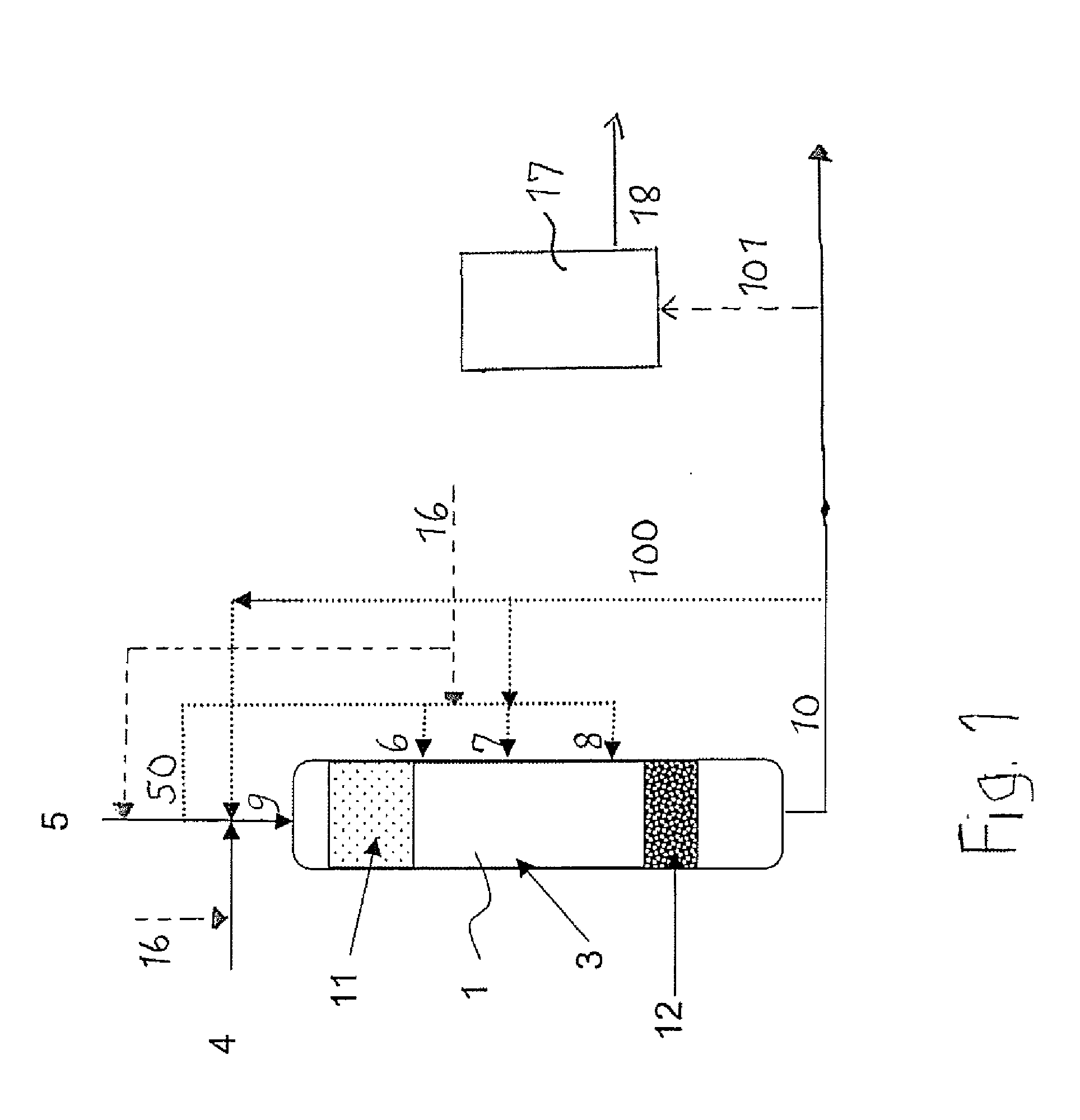Process and apparatus for producing hydrocarbons by hydrogenating a terpene feed
- Summary
- Abstract
- Description
- Claims
- Application Information
AI Technical Summary
Benefits of technology
Problems solved by technology
Method used
Image
Examples
example 1
[0092]Crude turpentine obtained from kraft pulping process, i.e. CST, was used as a crude turpentine feed. The crude turpentine comprised 50-60% α-pinene, 20-30% of Δ-carene, the rest being other terpenes. The sulphur content was about 1.5%.
TABLE 1FeedCSTSulphur content (%)about 1.5Pumping of feed (Vfeed) (g / h) 10CatalystNiMo / Al2O3Amount of catalyst (g) 10Reaction pressure (bar) 50H2 (l / h) 15WHSV (h−1)about 1Temperature of bed (° C.) 300H2 feed / turpentine feed (NI / l) 1250
[0093]The catalyst was packed into one layer in the reactor.
[0094]The composition of the product obtained was measured for two samples. For the first sample, no hydrogen sulphide was removed from the product sample. This is denoted by sample number 1 in Table 2 below. For the second sample, hydrogen sulphide was removed from the product sample by bubbling it with gas. This is denoted by sample number 2. The results from the two analyses are summarized in Table 2.
TABLE 2Sample number12Sulphur (ppm)6010Density at 15° ...
example 2
[0096]The same turpentine feed as in Example 1 was used in this Example. The process parameters are summarized in Table 3 below. The catalyst was packed in two layers in the reactor. The first layer comprised of diluted catalyst and the second layer comprised of undiluted catalyst. The diluted catalyst layer comprised of 40% catalyst and 60% of SiC, calculated on volume basis.
TABLE 3FeedCSTSulphur content (%)about 1.5Pumping of feed (Vfeed) (g / h) 40CatalystNiMo / Al2O3Amount of catalyst (g)30 (10 g diluted + 20 g undiluted)Reaction pressure (bar) 50H2 (l / h) 30WHSV (h−1)about 1.3Temperature of bed (° C.)340H2 feed / turpentine feed (NI / l)640
[0097]As in Example 1, the composition of the product obtained was measured for two samples. The sample numbers have the same meanings as in Example 1.
TABLE 4Sample number12Sulphur (ppm)606Density at 15° C. (g / mL)0.82020.8202Vapour pressure (DVPE)MON8787RON9696Benzene contentOxidation stability>1576>1576Hydrocarbon type contentOlefins1.71.7Aromatics28...
example 3
[0106]The products obtained in Examples 1 and 2, from which hydrogen sulphide was removed by bubbling with inert gas, were blended with a standard 95E gasoline in various mixing ratios. The mixing ratios were as follows:[0107]Sample 1: 95E gasoline blended with 5% of sample number 2 of Example 1.[0108]Sample 2: 95E gasoline blended with 10% of sample number 2 of Example 1.[0109]Sample 3: 95E gasoline blended with 5% of sample number 2 of Example 2.[0110]Sample 4: 95E gasoline blended with 10% of sample number 2 of Example 2.
TABLE 595E gasolineSample 1Sample 2Sample 3Sample 4MON85.485.384.985.285.0RON95.895.394.595.695.1
[0111]The test results show that when using the product obtained by the process of the invention as an additive in a standard 95E gasoline, no significant change in the octane numbers was observed.
PUM
| Property | Measurement | Unit |
|---|---|---|
| Temperature | aaaaa | aaaaa |
| Temperature | aaaaa | aaaaa |
| Temperature | aaaaa | aaaaa |
Abstract
Description
Claims
Application Information
 Login to view more
Login to view more - R&D Engineer
- R&D Manager
- IP Professional
- Industry Leading Data Capabilities
- Powerful AI technology
- Patent DNA Extraction
Browse by: Latest US Patents, China's latest patents, Technical Efficacy Thesaurus, Application Domain, Technology Topic.
© 2024 PatSnap. All rights reserved.Legal|Privacy policy|Modern Slavery Act Transparency Statement|Sitemap



